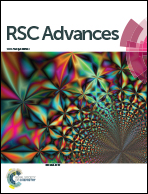pH-Responsive supramolecular hydrogels for codelivery of hydrophobic and hydrophilic anticancer drugs†
Abstract
Codelivery of multiple drugs with one kind of drug carrier provides a promising strategy to suppress the drug resistance and achieve the enhanced therapeutic effect in cancer treatment. In this work, we successfully developed multifunctional supramolecular hydrogels based on in situ host–guest inclusion between polymer-drug conjugates and α-cyclodextrin to codeliver hydrophobic and hydrophilic anticancer drugs with pH-trigged release properties. Taking advantage of the strong hydrophobicity of 4β-aminopodophyllotoxin (NPOD), a derivative of podophyllotoxin (POD), the NPOD molecule was conjugated to low-molecular-weight methoxypoly (ethylene glycol) (mPEG) chain via a pH-responsive imine bond, forming an amphiphilic polymer-drug conjugates (NPOD-PEG). After adding α-cyclodextrin (α-CD) into the NPOD-PEG solutions, the stable supramolecular hydrogels were formed based on a combination of the partial inclusion complexation between one end of the mPEG blocks and α-CD and the hydrophobic aggregation of NPOD groups. The formed hydrogels could further efficiently load another hydrophilic anticancer drug doxorubicin (DOX) for combination therapy purposes. The hydrogel demonstrated unique gel–sol transition properties and pH-dependent dual drug release behavior due to the hydrolysis of imine bond at acidic environments. Furthermore, the cytotoxicity results suggested that the DOX loaded NPOD-PEG/α-CD hydrogels showed an enhanced cytotoxicity in cancer cells in comparison with single modality treatment and the resulting hydrogels are characterized by producing an additive cytotoxicity to cancer cells. In fact, the codelivery of two anticancer drugs with different physicochemical properties and anticancer mechanisms was a key to opening the door to their controlled drug delivery and enhanced anticancer effect. Therefore, DOX loaded NPOD-PEG/α-CD hydrogels as pH-trigged drug codelivery systems might have important potential for combination cancer chemotherapy.


 Please wait while we load your content...
Please wait while we load your content...